Step into the enchanting world of Tilla Embroidery, where threads weave tales of heritage and sophistication.
Originating from the rich tapestry of South Asian culture, Tilla Embroidery is a timeless art form that has adorned garments for centuries.
The word “Tilla” translates to gold or metallic thread in Urdu, reflecting the opulence of this exquisite embroidery style.
Intricately handcrafted with meticulous attention to detail, Tilla Embroidery combines skilled craftsmanship with a touch of reality.
Gold and silver threads are entwined in elaborate patterns, creating a visual symphony that captures the essence of luxury and tradition.
As you delve deeper into the history of Tilla Embroidery, you’ll discover a legacy of royal patronage and craftsmanship that continues to flourish, transcending time and trends.
Join us on a journey through the shimmering legacy of Tilla Embroidery, where each stitch tells a story of cultural richness and sartorial elegance.
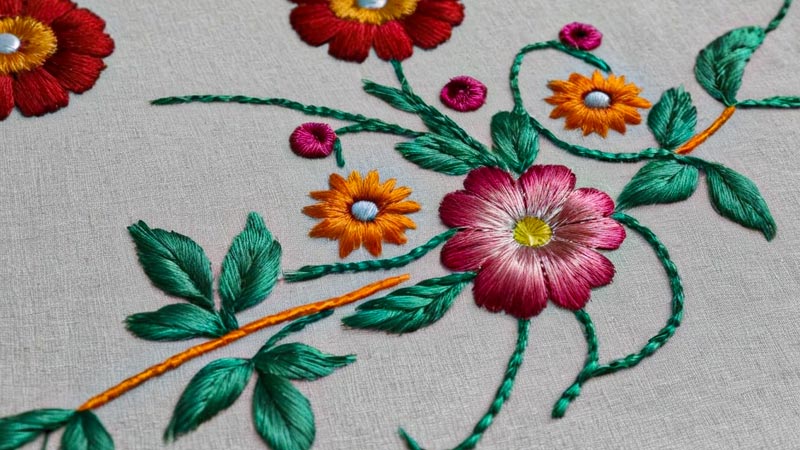
What Is Tilla Embroidery?
Tilla embroidery, also known as Tilla work, is a traditional form of embellishment that originated in South Asia. The word “Tilla” itself translates to gold or metallic thread in Urdu, reflecting the essence of this exquisite embroidery style.
This ancient craft uses metallic threads, primarily gold and silver, to create intricate and elaborate fabric designs. Tilla embroidery is deeply rooted in the region’s cultural heritage and has been a symbol of opulence and sophistication for centuries.
History and Origins
Tilla embroidery has a rich history dating back to the Mughal era in South Asia, particularly during the 16th and 17th centuries. It gained prominence as a form of royal embellishment, often adorning the garments of kings, queens, and nobility.
The Mughal emperors were known for patronizing the arts, and Tilla embroidery flourished under their influence. The craft continued to evolve over the centuries, incorporating various influences and techniques.
Techniques and Materials
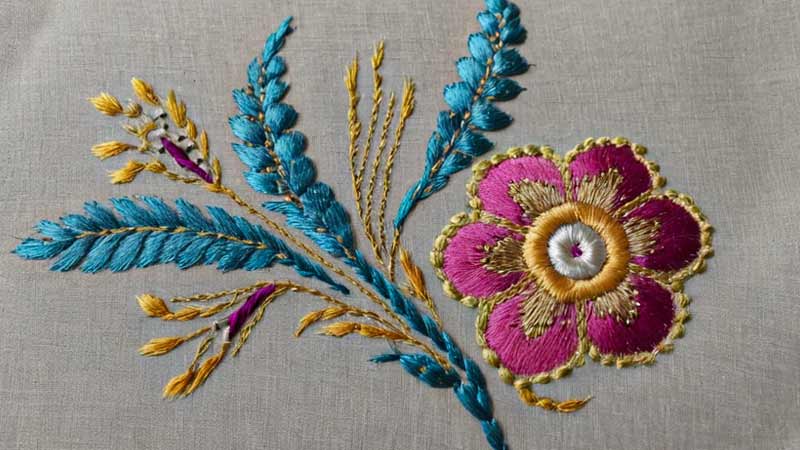
The hallmark of Tilla embroidery is the use of metallic threads, especially gold and silver, to create intricate patterns and designs. These threads are often wrapped around a silk or cotton core, adding texture and depth to the embroidery.
The craftsmanship involves skilled artisans meticulously hand-embroidering the metallic threads onto the fabric, creating ornate motifs and borders.
In addition to metallic threads, Tilla embroidery may incorporate other materials such as sequins, beads, and sometimes colored threads to enhance the visual appeal.
The use of metallic threads adds a touch of regality and imparts a shimmering quality to the fabric, making Tilla-embellished garments stand out.
Contemporary Revival
While rooted in tradition, Tilla embroidery has experienced a contemporary revival. Fashion designers are incorporating Tilla’s work into modern silhouettes, blending the timeless appeal of the craft with current fashion trends.
This fusion allows Tilla embroidery to transcend cultural boundaries and appeal to a global audience.
What Are the Uses of Tilla Embroidery?
Tilla embroidery is applied in various forms, from traditional ethnic wear to contemporary fashion. Its versatility allows it to grace different types of fabrics, including silk, velvet, georgette, and more. Here are some common uses of Tilla embroidery:
Bridal Wear
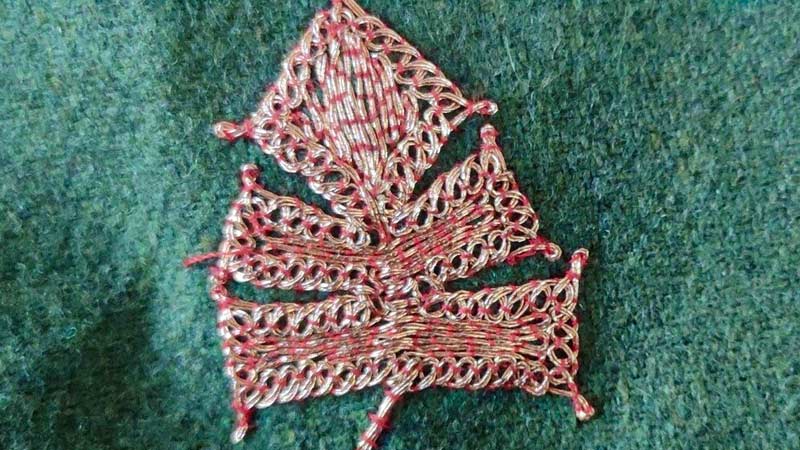
Tilla thread embroidery is strongly associated with bridal wear in South Asian cultures. Bridal lehengas, sarees, and dupattas often feature elaborate Tilla work, making the bride’s ensemble a symbol of opulence and tradition.
The metallic sheen of Tilla embroidery complements the grandeur of wedding ceremonies.
Formal Attire
Tilla-embellished outfits are popular choices for formal occasions and celebrations. Whether it’s a traditional kurta for men or an intricately embroidered anarkali suit for women, Tilla’s work adds a touch of elegance and sophistication suitable for festive gatherings and special events.
Accessories
Tilla embroidery isn’t limited to clothing; it also extends to accessories. Clutches, handbags, and footwear adorned with Tilla work are coveted for their ability to elevate an ensemble. Accessories featuring Tilla embroidery offer a way to incorporate this traditional craft into everyday fashion.
Home Décor
Tilla embroidery isn’t confined to personal attire; it also finds its way into home décor items. Cushion covers, table runners, and wall hangings featuring Tilla’s work bring a touch of luxury and cultural richness to interior spaces.
Ceremonial Textiles
Tilla embroidery designs are often employed to create ceremonial textiles such as prayer mats, ceremonial flags, and other religious artifacts. The intricate designs and metallic threads hold significance in the context of religious and cultural ceremonies.
What Are Some Popular Tilla Embroidery Designs and Stitches?

Tilla embroidery is renowned for its intricate and ornate designs, often characterized by elaborate motifs and patterns. Here are some common Tilla embroidery designs:
Floral Motifs
Flowers, leaves, and vines are popular motifs in Tilla embroidery. The metallic threads are skillfully arranged to create delicate and realistic floral patterns, adding a touch of nature’s beauty to the fabric.
Paisley Patterns
The timeless paisley motif is a staple in Tilla embroidery. It is often arranged in symmetrical or asymmetrical patterns, contributing to the overall elegance of the design.
Geometric Shapes
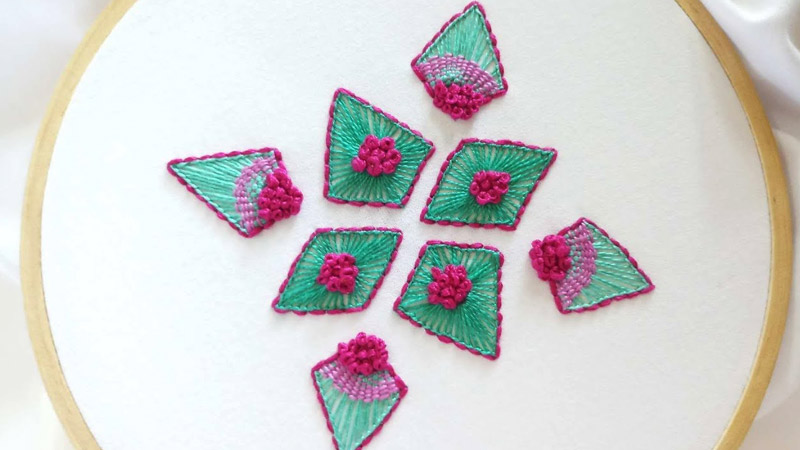
Tilla’s work sometimes incorporates geometric shapes like circles, triangles, and squares. These shapes are strategically placed to create visually appealing patterns and borders.
Peacock Motifs
Peacocks, with their majestic feathers, are symbolic in South Asian cultures. Tilla embroidery often features peacock motifs, showcasing the artisan’s skill in capturing the regal essence of these birds.
Scalloped Edges
Many Tilla embroidery designs include scalloped edges, providing a decorative border to the fabric. These edges may be adorned with small motifs or left plain to emphasize the metallic sheen of the threads.
Abstract Designs
Some contemporary Tilla embroidery designs embrace abstract and modern elements. These designs often blend traditional techniques with a more eclectic approach, catering to diverse fashion preferences.
Tilla Embroidery Stitches
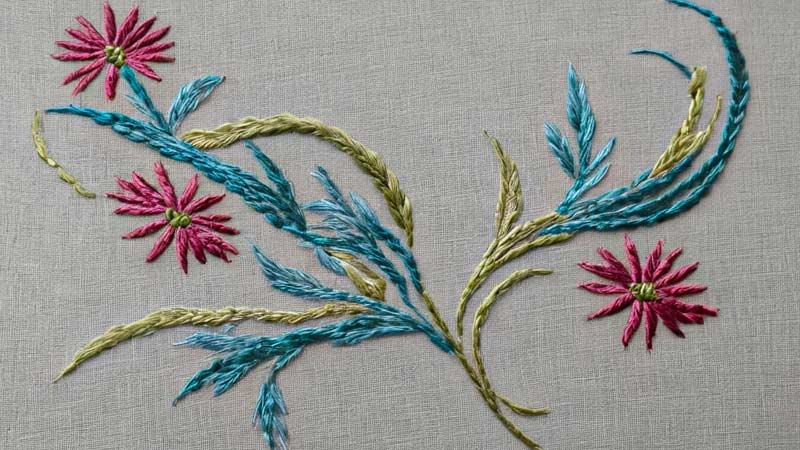
The beauty of Tilla embroidery lies in the meticulous stitching techniques used by skilled artisans. Here are some common stitches employed in Tilla embroidery:
Couching Stitch
This stitch involves securing the metallic thread onto the fabric with small stitches using a contrasting or matching thread. It allows for precise placement and control of the metallic threads.
Running Stitch
The running stitch is a basic embroidery stitch where the needle is passed through the fabric in a straight line. In Tilla embroidery, running stitches may be used to create borders or outline larger motifs.
Chain Stitch
Chain stitch is frequently used to create outlines and fillings in Tilla embroidery. It produces a continuous, chain-like line of stitches and is versatile for both curves and straight lines.
Zari Work
Zari is a type of embroidery where metallic threads, often gold or silver, are woven into the fabric. In Tilla embroidery, zari work is integral to creating the craft’s signature shimmer and luxurious texture.
Satin Stitch
Satin stitch is employed to fill in larger areas with a smooth, glossy finish. In Tilla embroidery, a satin stitch may be used to highlight specific motifs or create a contrast with other stitches.
French Knots
French knots are small, raised knots that add texture to the design. In Tilla embroidery, these knots may be strategically placed within motifs to enhance their three-dimensional appearance.
Understanding the diverse designs and stitches in Tilla embroidery showcases the craftsmanship and attention to detail that goes into creating garments and textiles adorned with this traditional art form.
How to Create Tilla Embroidery?
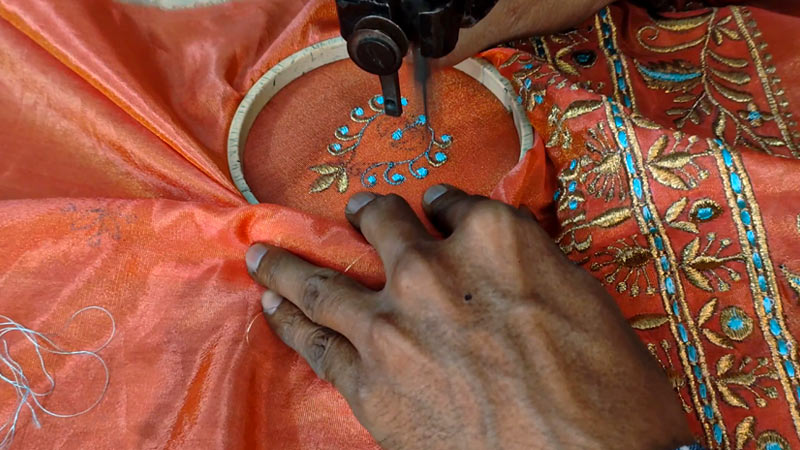
Creating Tilla embroidery involves a combination of skill, precision, and an understanding of the traditional techniques associated with this art form. Here’s a basic guide on how to create Tilla embroidery:
Prepare the Fabric
Choose a fabric suitable for Tilla embroidery, considering factors like texture and weight. Wash and iron the fabric to ensure a smooth working surface if necessary.
Place the fabric in an embroidery hoop, stretching it taut. This provides a stable surface for the embroidery.
Create a Design
Decide on the design you want to embroider. You can use a pre-drawn sketch or create a pattern directly on the fabric with a water-soluble pen.
Thread a thin needle with the metallic thread. Using Zari thread may need to be handled carefully as it can be delicate.
Start with Couching Stitches
Begin by securing the metallic thread to the fabric using couching stitches. These stitches will hold the thread in place and allow you to create the desired design.
Use running stitches to outline the main features of your design. This will serve as a guide for more intricate stitching.
Add Chain Stitches
Incorporate chain stitches for filling in larger areas or creating thicker outlines. This stitch adds texture and depth to the embroidery.
Use satin stitches for filling smaller spaces or emphasizing specific motifs. This stitch creates a smooth, glossy finish.
Integrate Zari Work
Introduce zari work by weaving metallic threads into the fabric. This step enhances the overall sheen and texture of Tilla embroidery.
If desired, add sequins and beads to enhance the design. These embellishments can be stitched onto the fabric to create a more intricate and decorative effect.
French Knots for Detailing
Use French knots for finer details and to create raised knots within the design. This adds a three-dimensional aspect to the embroidery.
Periodically secure loose ends of metallic thread by stitching them into the fabric. This ensures durability and prevents unraveling.
Finish and Trim
Once the embroidery is complete, carefully remove the fabric from the hoop. Trim any excess threads and tidy up the back of the embroidery if necessary.
FAQs
What materials are commonly used in Tilla Embroidery?
Common materials used in Tilla embroidery include metallic threads (gold and silver), zari thread, fabric (such as silk or velvet), embroidery hoops, and needles. Optional embellishments like sequins and beads may also be incorporated.
How is Tilla Embroidery different from other embroidery styles?
Tilla embroidery is distinguished by its exclusive use of metallic threads, creating a distinctive shimmering effect. Its intricate designs often feature floral motifs, paisley patterns, and geometric shapes, setting it apart from other embroidery styles.
What are the typical applications of Tilla Embroidery?
Tilla embroidery is commonly used in bridal wear, formal attire, accessories like clutches and footwear, and even in home décor items such as cushion covers and table runners. Its versatility allows it to be incorporated into various textile and fashion items.
Can Tilla Embroidery be done at home, or is it a specialized craft?
Tilla embroidery can be done at home with the right materials and practice. While skilled artisans often create intricate Tilla designs, beginners can start with simpler patterns and gradually develop their skills.
Conclusion
Tilla Embroidery is a testament to the enduring allure of cultural heritage and artistic finesse. Its golden threads not only embellish fabrics but also weave together the stories of generations past.
As we embrace the intricacies of this time-honored craft, we find ourselves not merely adorned in garments but connected to a legacy that spans epochs.
Tilla Embroidery’s significance extends beyond its aesthetic appeal; it embodies a commitment to preserving traditions and celebrating the artistry of skilled hands.
As we continue to appreciate and incorporate Tilla Embroidery into contemporary fashion, we carry forward a piece of history that refuses to fade.
Practice is the key when it comes to perfecting the art of Tilla Embroidery. Let the shimmering elegance of Tilla Work Embroidery be a reminder that amidst evolving trends, the beauty of cultural craftsmanship remains eternal a golden thread linking the past, present, and future.
Leave a Reply